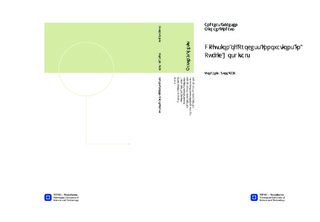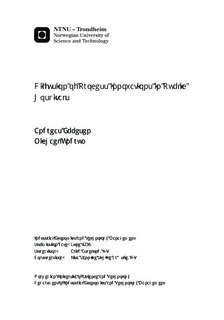| dc.contributor.advisor | Aspelund, Arild | nb_NO |
| dc.contributor.advisor | Schüle Græslie, Lisa Synnøve | nb_NO |
| dc.contributor.author | Undrum, Michael | nb_NO |
| dc.contributor.author | Ebbesen, Andreas | nb_NO |
| dc.date.accessioned | 2014-12-19T14:31:01Z | |
| dc.date.available | 2014-12-19T14:31:01Z | |
| dc.date.created | 2014-09-09 | nb_NO |
| dc.date.issued | 2014 | nb_NO |
| dc.identifier | 745171 | nb_NO |
| dc.identifier | ntnudaim:11391 | nb_NO |
| dc.identifier.uri | http://hdl.handle.net/11250/266855 | |
| dc.description.abstract | Norwegian hospitals are challenged by demographic changes, an increasingly complex clinical picture and longer waiting lines. At the same time hospitals struggle with adopting process innovations aiming at improving efficiency and productivity at a satisfactory rate. This study is a specific contribution to an increased understanding of the diffusion of process innovations in public health care. The first question answered by this study is related to which specific determinants that affect the diffusion and adoption of process innovations in Norwegian, public hospitals. The second question considers how the efforts of process improvements observed in Norwegian hospitals relate to the innovation-decision model by E. Rogers (2003). To answer these questions a case study research was selected and 15 interviews with six unique case hospitals and three independent specialists were conducted. This provided the data needed to identify both the relevant determinants and new insight in the efforts for process improvement in Norwegian hospitals.This study has four main contributions to theory. First, the five most relevant determinants for the diffusion of process innovations were found to be reinforcement by management, meaning, professionalism, collective action, and experimentation. Second, the findings suggest that interconnectedness of determinants plays an important role for process innovations. Third, the identification of three phases in the process improvement in hospitals resulted in a proposed modification to the innovation-decision model. Fourth, the framework of determinants applied to the phases of process improvement yielded insight in the different determinants affecting each of the identified phases. Implications for managers are a need for increased understanding of how the local process is affected by various elements depending on the phase of a project and increased understanding of the importance of reinforcement by management in facilitating process innovation. Implications for policymakers are that the diffusion of process innovations involves high degrees of inspiration and adaptation, making it hard to facilitate the diffusion of a particular innovation and that the direct influence of policymakers seems to be low despite their given mandate to facilitate development. | nb_NO |
| dc.language | eng | nb_NO |
| dc.publisher | Institutt for industriell økonomi og teknologiledelse | nb_NO |
| dc.title | Diffusion of Process Innovations in Public Hospitals | nb_NO |
| dc.type | Master thesis | nb_NO |
| dc.source.pagenumber | 81 | nb_NO |
| dc.contributor.department | Norges teknisk-naturvitenskapelige universitet, Fakultet for samfunnsvitenskap og teknologiledelse, Institutt for industriell økonomi og teknologiledelse | nb_NO |

